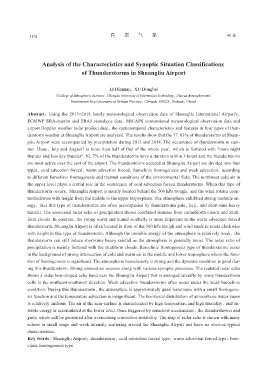Page 215 - 《高原气象》2021年第5期
P. 215
高 原 气 象 40 卷
1176
Analysis of the Characteristics and Synoptic Situation Classifications
of Thunderstorms in Shuangliu Airport
LI Diannan,XU Dongbei
(College of Atmospheric Sciences,Chengdu University of Information Technology,Plateau Atmosphereand
Environment Key Laboratory of Sichuan Province,Chengdu 610225,Sichuan,China)
Abstract:Using the 2013-2018 hourly meteorological observation data of Shuangliu International Airport's,
ECMWF ERA-interim and ERA5 reanalysis data,MICAPS conventional meteorological observation data and
airport Doppler weather radar product data,the spatiotemporal characteristics and features in four types of thun‐
derstorm weather at Shuangliu Airport are analyzed. The results show that the 77. 03% of thunderstorms at Shuan‐
gliu Airport were accompanied by precipitation during 2013 and 2018. The occurrence of thunderstorm in sum‐
mer(June,July and August)is more than half of that of the whole year,which is featured with "more night
thunder and less day thunder". 82. 7% of the thunderstorms have a duration within 3 hours and the thunderstorms
are most active over the east of the airport. The thunderstorms occured at Shuangliu Airport are divided into four
types,cold advection forced,warm advection forced,baroclinic frontogenesis and weak advection,according
to different baroclinic frontogenesis and thermal conditions of the environmental field. The northwest cold air in
the upper level plays a crutial role in the occurrence of cold advection forced thunderstorms. When this type of
thunderstorm occurs,Shuangliu Airport is mostly located behind the 500 hPa trough,and the wind rotates coun‐
terclockwise with height from the middle to the upper troposphere. The atmosphere exhibited strong unstable en‐
ergy,thus this type of thunderstorms are often accompanied by thunderstorm gale,hail,and short-time heavy
rainfall. The associated radar echo of precipitation shows combined features from cumuliform clouds and strati‐
form clouds. In contrast,the strong warm and humid southerly is more important in the warm advection forced
thunderstorm. Shuangliu Airport is often located in front of the 500 hPa trough and wind tends to rotate clockwise
with height in this type of thunderstorm. Although the unstable energy of the atmosphere is relatively weak,the
thunderstorm can still induce short-time heavy rainfall as the atmosphere is generally moist. The radar echo of
precipitation is mainly featured with the stratiform clouds. Baroclinic frontogenesis type of thunderstorms occur
in the background of strong intersection of cold and warm air in the middle and lower troposphere where the func‐
tion of frontogenesis is significant. The atmospheric baroclinicity is strong and the dynamic condition is good dur‐
ing this thunderstorm. Strong convection occures along with various synoptic processes. The realated radar echo
shows a radar bow-shaped echo band near the Shuangliu Airport that is arranged laterally by many thunderstorm
cells in the northeast-southwest direction. Weak advection thunderstorms often occur under the weak baroclinic
condition. During this thunderstorm,the atmosphere is approximately quasi-barotropic with a small frontogene‐
sis function and the temperature advection is insignificant. The horizontal distribution of atmospheric water vapor
is relatively uniform. The air at the near-surface is characterized by high temperature and high humidity,and un‐
stable energy is accumulated at the lower level. Once triggered by somehow mechanisms,the thundershower and
gusty winds will be generated after overcoming convective instability. The map of radar echo is shown with many
echoes in small range and weak intensity scattering around the Shuangliu Airport and have no obvious typical
characteristics.
Key words:Shuangliu Airport;thunderstorm;cold advection forced type;warm advection forced type;baro‐
clinic frontogenesis type

